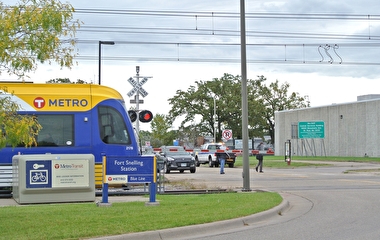Following Joung Lee’s opening presentation at CTS’s 2017 research conference, a panel of Minnesota leaders and experts shared their perspectives on transportation infrastructure funding.
Tracy Hatch, Deputy Commissioner, Minnesota Department of Transportation
“We have had federal continuing resolutions and short-term reauthorization, but we know that longer periods work better for getting big projects in the queue. The other challenge is that there is only so much capacity with our existing staff. When thinking about construction, folks tend to think only of actual payments to contractors, but there is so much else needed to get big projects out the door in terms of engineering, administration, planning, and right-of-way purchase—meaning the project delivery pipeline is only so big. If we want to take on big projects quickly, we need to increase the size of that pipe, because in Minnesota we are maxed out in terms of what we can deliver quickly.”
Jeffrey Heilstedt, Vice President, Transportation Regional Business Line Leader, Midwest Region, AECOM
“While there has been a lot of criticism of public-private partnerships (P3s), there are also significant benefits. Using the design-build process, we can potentially see projects happen much more quickly with significant cost savings...If we want to be in lockstep with the administration, we have to start thinking in terms of P3s, which can be designed to reduce risk by including maintenance, operations, and defect repairs in the terms of the contract...More broadly, there are partnerships DOTs can enter into to achieve first-class facilities. For example, could you partner with a local utility agency to get in-line vehicle charging on certain segments of road for electric vehicles? That is technology that exists today.”
Jim McDonough, Commissioner, Ramsey County
“We need to work on bridging the urban and rural divide in our state. Hennepin and Ramsey Counties are the economic engines that move the state forward, and while rural areas need roads, we all need investment in the metro area to keep those engines going. If rural areas lose their young folks to metro areas, we want to lose them to the Twin Cities—not to Denver, Portland, or Phoenix. Keeping local Minnesotans here brings stability, long-term vision, and leadership, so we need to work together and focus on building bridges and connections with stakeholders who have specific visions and can help move everyone forward.”
Jerry Zhao, Associate Professor, Humphrey School of Public Affairs
“At the Humphrey School, we have created the Minnesota Transportation Finance Database to provide data related to this challenge of transportation funding. In this country, data related to transportation money exists, but is not easily accessible—it is scattered and fragmented. Our research pieces together and aggregates data from many sources, making it possible to research how the whole system works for the first time. By breaking down where transportation money comes from at the state, local, and county level, we’ve created a tool that is tremendously helpful for state and local decision making.”


